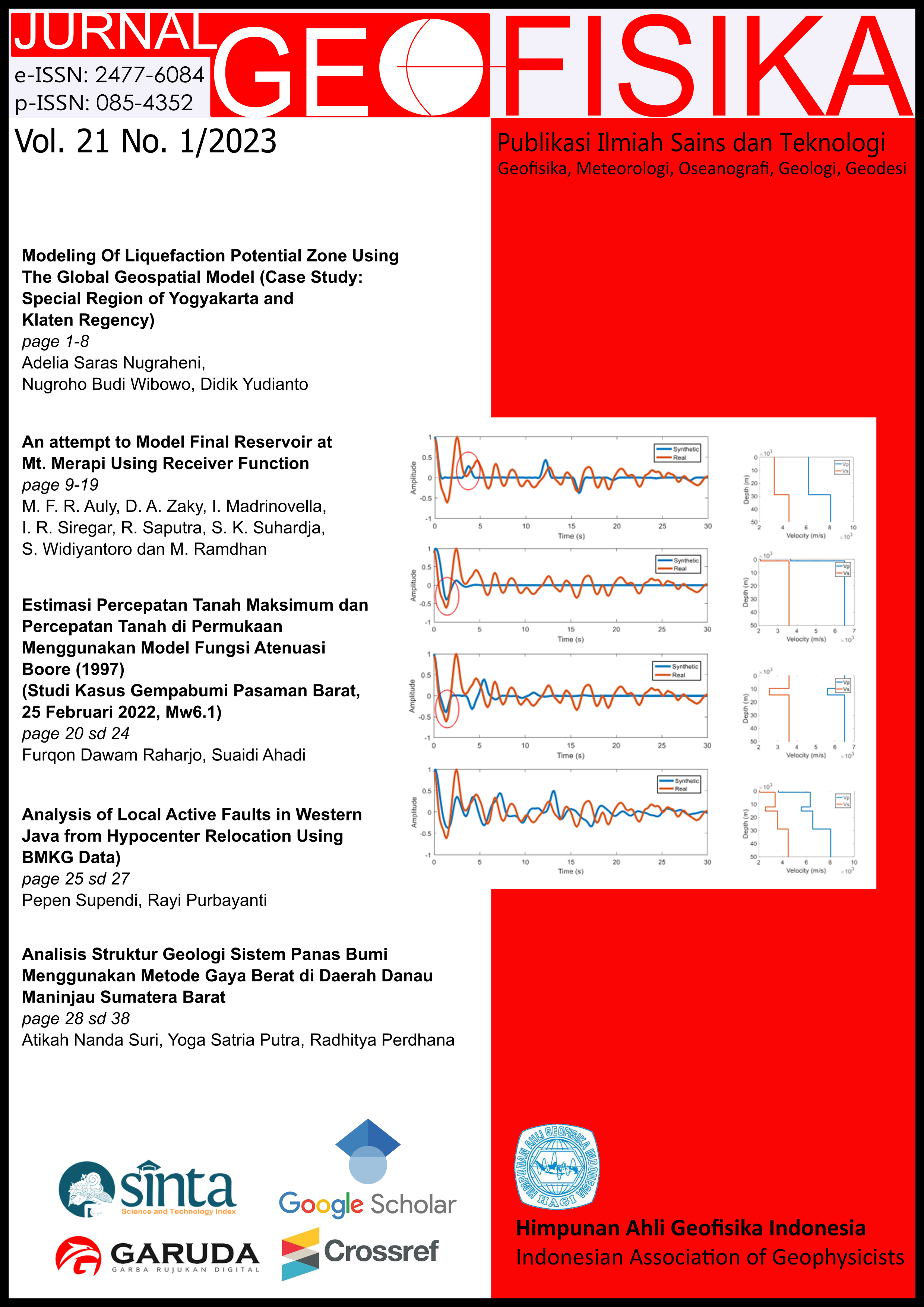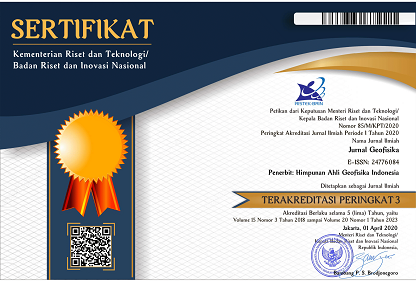An attempt to Model Final Reservoir at Mt. Merapi Using Receiver Function
Keywords
Synthetic Receiver Function, Gunung Merapi, Reservoir Magma, Low Velocity ZoneAbstract
Studi di daerah Gn. Merapi sudah banyak dilakukan sebelumnya untuk mengetahui kondisi di bawah permukaan pada area tersebut, khususnya untuk mengetahui mekanisme vulkanik dari Gn. Merapi itu sendiri. Hal yang sering menjadi topik pembahasan pada studi di Gn. Merapi adalah kondisi dari reservoir magma yang ada di bawah permukaan. Untuk memperkirakan hal tersebut dilakukan teknik receiver function dengan membuat model kecepatan sintetik yang kemudian diolah menjadi kurva synthetic receiver function. Hasil synthetic receiver function kemudian dikorelasikan dengan hasil receiver function observasi hingga didapatkan korelasi yang paling baik. Sebelum dilakukan pembuatan synthetic receiver function untuk mencitrakan kondisi bawah permukaan Gn. Merapi, perlu dilakukan terlebih dahulu analisis awal terhadap respon hasil receiver function dari model sederhana yang dibuat dengan memberikan sumber-sumber sinyal utama pada kurva receiver function yang dihasilkan agar mempermudah pembuatan model kecepatan sintetik. Sumber-sumber respon sinyal utama yang mempengaruhi bacaan receiver function di antaranya adalah kontras nilai kecepatan gelombang seismik terutama Vs, adanya lapisan sedimen yang memiliki ketebalan tipis, adanya zona berkecepatan rendah (low velocity zone) yang diinterpretasikan sebagai reservoir magma, dan kedalaman dari batas kerak dan mantel atas yaitu moho discontinuity. Berdasarkan hasil synthetic receiver function di stasiun ME25, ME32 dan ME36, didapatkan kedalaman dari moho berkisar antara 26-29 km dan semakin dangkal ke arah Gn. Merapi, yaitu arah selatan dari daerah studi. Kedalaman dari low velocity zone juga bervariasi yaitu berkisar antara 5-15 km dan juga semakin dangkal ke arah selatan.
References
Beauducel, F., & Cornet, F. H., (1999). Collection and three‐dimensional modeling of GPS and tilt data at Merapi volcano, Java. Journal of Geophysical Research: Solid Earth, 104(B1), 725-736.
Camus, G., Gourgaud, A., Mossand-Berthommier, P.-C. & Vincent, P. M., 2000. Merapi (Central Java, Indonesia): an outline of the struc-tural and magmatological evolution, with a special emphasis to the major pyroclastic events, J. Volcanol. Geotherm. Res., 100, 139–163.
Christensen, N. I., & Mooney, W. D., 1995,. Seismic velocity structure and composition of the continental crust: A global view. Journal of Geophysical Research: Solid Earth, 100(B6), 9761-9788.
Christensen, N. I., & Stanley, D., 2003. Seismic velocities and densities of rocks. In International Geophysics (Vol. 81, pp. 1587-1594). Academic Press.
Clements, B., Hall, R., Smyth, H. R. & Cottam, M. A., 2009. Thrusting of a volcanic arc: a new structural model for Java, Petrol. Geosci., 15, 159–174. http://dx.doi.org/10.1144/1354- 079309-831.
Hall, R., & Spakman, W. (2002). Subducted slabs beneath the eastern Indonesia–Tonga region: insights from tomography. Earth and Planetary Science Letters, 201(2), 321-336.
Hetland, E. A., Wu, F. T., & Song, J. L., 2004. Crustal structure in the Changbaishan volcanic area, China, determined by modeling receiver functions. Tectonophysics, 386(3-4), 157-175.
Hidayati, S., Ishihara, K., Iguchi, M. & Ratdomopurbo, 2008. Focal mechanism of volcano-tectonic earthquake at Merapi volcano, Indonesia, Indonesian J. Phys., 19(2), 75 - 82.
Koulakov, I., Bohm, M., Asch, G., Lühr, B.-G., Manzanares, A., Brotopuspito, K. S., Fauzi, P., Purbawinata, M. A., Puspito, N. T., Ratdomopurbo, A., Kopp, H., Rabbel, W. & Shevkunova, E., 2007. P and S velocity structure of the crust and the upper mantle beneath central Java from local tomography inversion, J. Geophys. Res., 112, B08310, http://dx.doi.org/10.1029/2006JB004712.
Kennett, B.L.N. Engdahl, E.R. & Buland R., 1995. Constraints on seismic velocities in the Earth from travel times, Geophys J Int, 122, 108-124
Langston, C. A., 1977. Corvallis, Oregon, Crustal and upper mantle structure from teleseismic P and S waves, Bull. Seismol. Soc. Am., 67, 713–724.
Langston, C. A., 1979. Structure under Mount Rainier, Washington, inferred from teleseismic body waves. Journal of Geophysical Research: Solid Earth, 84(B9), 4749-4762.
Levin, V., & Park, J., 1997. P-SH conversions in a flat-layered medium with anisotropy of arbitrary orientation. Geophysical Journal International, 131(2), 253-266.
Madrinovella, I., Zaki, D. A., Riesky, F., Widyanti, S., Zulhan, Z., Ramdhan, M., & Suhardja, S., 2019. Pre-results of Application of PP phase for Receiver Function data Processing from A Broad Band Data Station in West Java, Indonesia. Joint Convention Yogyakarta 2019, HAGI
Owens, T. J., 1984. Determination of crustal and upper mantle structure from analysis of broadband teleseismic P-waveforms, Ph.D. thesis, Department of Geology and Geophysics, The University of Utah.
Plešinger, A., Hellweg, M., & Seidl, D., 1986. Interactive high-resolution polarization analysis of broad-band seismograms. Journal of Geophysics| IF 32.18, 59(1), 129-139.
Ramdhan, M., Widiyantoro, S. Nugraha, A. D., Métaxian, J.-P., Rawlinson, N., Saepuloh, A., Kristyawan, S., Sembiring, A. S., Budi-Santoso, A., Laurin, A. & Fahmi, A. A., 2019. Detailed seismic imaging of Merapi volcano, Indonesia, from local earthquake travel-time tomography, J. Asian Earth Sci. Vol 177, p134-135.
Ratdomopurbo, A. & Poupinet, G., 2000. An overview of the seismicity of Merapi volcano (Java, Indonesia), 1983–1994, J. Volcanol. Geotherm. Res., 100, 193–214. https://doi.org/10.1016/S0377-0273(00)00137-2.
Simons, W. J. F., Socquet, A., Vigny, C., Ambrosius, B. A. C., Haji Abu, S., Chaiwat Promthong, Subarya, C., Sarsito, D. A., Matheussen, S., Morgan, P. & Spakman, W., 2007. A decade of GPS in Southeast Asia: Resolving Sundaland motion and boundaries, J. Geophys. Res., 112, doi:10.1029/2005JB003868.
Smyth, H. R., Hall, R. & Nichols, G. J., 2008. Cenozoic volcanic arc history of east Java, Indonesia: the stratigraphic record of eruptions on an active continental margin, In: Draut, A. E., Clift, P. D., Scholl, D. W. (Eds.), Formation and Applications of the Sedimentary Record in Arc Collision Zones, Geol. Soc. Am. Spec., Paper 436, pp. 199–222. http://dx.doi.org/10.1130/2008.2436(10).
Suhardja, S. K., Widiyantoro, S., Métaxian, J. P., Rawlinson, N., Ramdhan, M., & Santoso, B. S., 2019. Crustal thickness beneath Mt. Merapi and Mt. Merbabu, Central Java, Indonesia, inferred from receiver function analysis.
Surono, Jousset, P., Pallister, J., Boichu, M., Buongiorno, M.F., Budisantoso, A., Costa, F., Andreastuti, S., Prata, F., Schneider, D., Clarisse, L., Humaida, H., Sumarti, S., Bignami, C., Griswold, J., Carn, S., Oppenheimer, C. & Lavigne, F., 2012. The 2010 explosive eruption of Java’s Merapi volcano—A “100-year” event, J. Volcanol. Geotherm. Res. 241–242, 121– 135, https://doi.org/10.1016/j.jvolgeores.2012.06.018.
Tiede, C., Camacho, A. G., Gerstenecker, C., Fernández, J. & Suyanto, I., 2005. Modeling the density at Merapi volcano area, Indonesia, via the inverse gravimetric problem, Geochem. Geophys. Geosyst., 6, Q09011, doi:10.1029/2005GC000986.
Wagner, D., Koulakov, I., Rabbel, W., Luehr, B.-G., Wittwer, A., Kopp, H., Bohm, M., Asch, G. & MERAMEX Scientists, 2007. Joint inversion of active and passive seismic data in Central Java, Geophys. J. Int., 170, 923–932. http://dx.doi.org/ 10.1111/j.1365-246X.2007.03435.x.

This work is licensed under a Creative Commons Attribution 4.0 International License.
The copyright of all articles belongs to the authors. All other copyrights is held by the Journal











